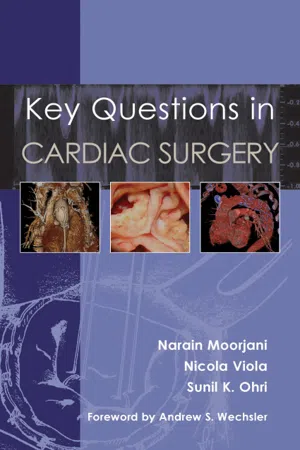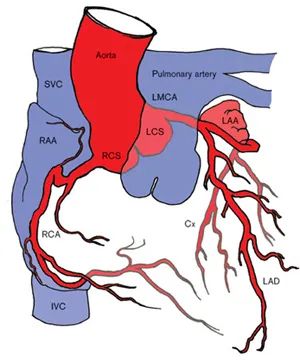
- English
- ePUB (mobile friendly)
- Available on iOS & Android
About This Book
Winner of a HIGHLY COMMENDED AWARD in the Surgical specialties category of the 2011 BMA Medical Book Competition. Key Questions in Cardiac Surgery will systematically cover all the main topics involved in the current practice of a cardiac surgeon. It will incorporate current guidelines for practice (such as from the American Heart Association and European Society of Cardiology) and up-to-date information based on current literature. The data and body of knowledge presented in this book are strictly evidence-based which makes it ideal as a revision aid for residents/registrars undertaking their Cardiothoracic Surgery Board examinations around the world. Although these examinations vary in format in different countries, this book is applicable to all cardiothoracic surgical trainees. Its concise, yet complete coverage of the important topics, make it the ideal guide to answer the key questions in cardiac surgery that are asked within the confines of an examination. Cardiologists, cardiothoracic intensive care unit specialists, nursing staff, physiotherapists and other professions allied to medicine, both surgical and cardiological, will also find the book useful in terms of the indications and surgical management of these patients, as they are integral to the cardiac surgical process.
Frequently asked questions
Information
Chapter 1
Cardiac anatomy
| 1 | Describe the anatomy of the coronary artery system (Figure 1) |

| • | The coronary artery system originates from the aortic root and consists of the left and right coronary arteries and their individual branches. |
| • | The left coronary artery originates from the left coronary ostium as the left main stem and divides early into the left anterior descending artery (also known as the anterior interventricular artery) and circumflex artery (see below). |
| • | The right coronary artery originates from the right coronary ostium and eventually terminates as the posterior descending artery (also known as the posterior interventricular artery) and posterior left ventricular artery (see below). |
| 2 | Describe the anatomy of the left main coronary artery (Figure 2) |
| • | The left main coronary artery (left main stem) courses from the left coronary sinus of the aorta in an anterior and inferior direction between the pulmonary trunk and the left atrial appendage. |
| • | It then divides into two major arteries of nearly equal diameter, the left anterior descending artery and the circumflex artery. Typically, no branches are seen before this bifurcation. |
| • | In some patients, the left main coronary artery trifurcates into the intermediate coronary artery (ramus intermedius), left anterior descending artery and circumflex artery. |
| • | The left main coronary artery is typically 10-40mm in length but may be absent in patien... |
Table of contents
- Cover Page
- Title Page
- Copyright Page
- Contents
- Preface
- Foreword
- Acknowledgements
- Abbreviations
- Recommendations and evidence
- Chapter 1: Cardiac anatomy
- Chapter 2: Cardiac physiology
- Chapter 3: Cardiac pharmacology
- Chapter 4: Electrocardiography
- Chapter 5: Echocardiography
- Chapter 6: Cardiac catheterisation
- Chapter 7: Radiological imaging
- Chapter 8: Cardiopulmonary bypass
- Chapter 9: Cardiopulmonary bypass scenarios
- Chapter 10: Adjuncts to cardiopulmonary bypass
- Chapter 11: Myocardial protection
- Chapter 12: Aortic valve disease
- Chapter 13: Mitral valve disease
- Chapter 14: Tricuspid valve disease
- Chapter 15: Infective endocarditis
- Chapter 16: Thoracic aortic disease
- Chapter 17: Coronary artery disease
- Chapter 18: Heart failure
- Chapter 19: Arrhythmia surgery
- Chapter 20: Pericardial disease, cardiac tumours and cardiac trauma
- Chapter 21: Cardiac anaesthesia and intensive care management
- Chapter 22: Postoperative management
- Appendix I: Transoesophageal echocardiographic views
- Appendix II: Transthoracic echocardiographic views
- Appendix III: Normal echocardiographic values
- Appendix IV: Standard coronary angiographic views
- Appendix V: Normal arterial blood gas values
- Appendix VI: Normal cardiac physiological values
- Appendix VII: AHA guidelines for quantifying the severity of valvular disease
- Appendix VIII: EuroSCORE
- Index